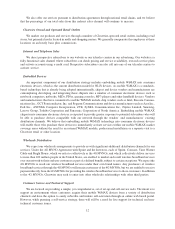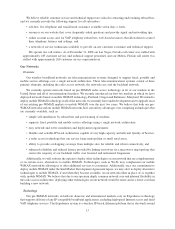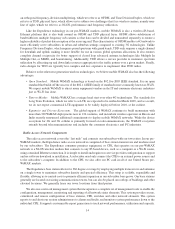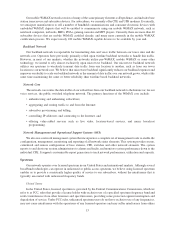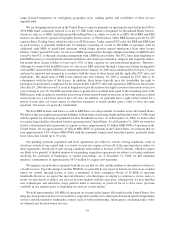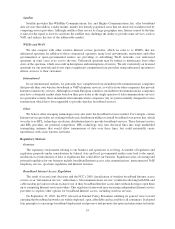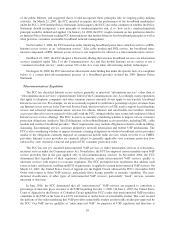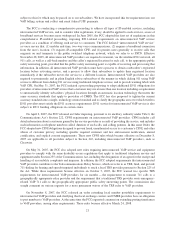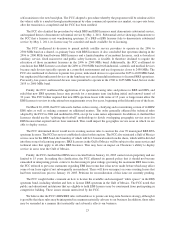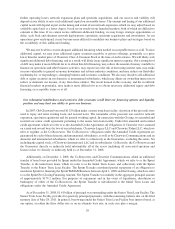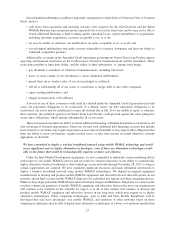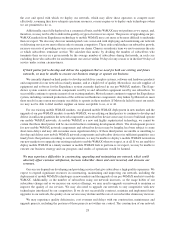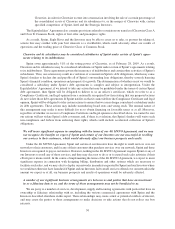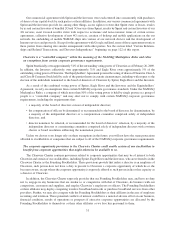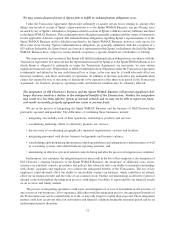Clearwire 2008 Annual Report Download - page 34
Download and view the complete annual report
Please find page 34 of the 2008 Clearwire annual report below. You can navigate through the pages in the report by either clicking on the pages listed below, or by using the keyword search tool below to find specific information within the annual report.Th
e FCC
i
s cons
id
er
i
ng a
ddi
t
i
ona
l
regu
l
at
i
ons,
i
nc
l
u
di
ng w
h
at
i
ntercarr
i
er compensat
i
on reg
i
me s
h
ou
ld
app
l
y
t
o interconnected VoIP traffic over the PSTN. Accordin
g
l
y
, our costs to provide VoIP service ma
y
increase, whic
h
w
ill impact our pricing decisions in relation to our competitors and our profit margins, if any
.
O
nAu
g
ust 5, 2005, the FCC adopted an Order findin
g
that both facilities-based broadband Internet access
p
roviders and interconnected VoIP providers are sub
j
ect to CALEA, which requires service providers covered b
y
th
at statute to
b
u
ild
certa
i
n
l
aw en
f
orcement surve
ill
ance ass
i
stance capa
bili
t
i
es
i
nto t
h
e
i
r commun
i
cat
i
ons
n
etworks and to maintain CALEA-related s
y
stem securit
y
policies and procedures. On Ma
y
3, 200
6
, the FC
C
adopted an additional Order addressing the CALEA compliance obligations of these providers. In that order, th
e
F
CC: (1) a
ffi
rme
d
t
h
e May 14, 2007 ass
i
stance-capa
bili
ty comp
li
ance
d
ea
dli
ne; (2)
i
n
di
cate
d
comp
li
ance stan
d
ar
d
s
are to
b
e
d
eve
l
ope
dby
t
h
e
i
n
d
ustr
y
w
i
t
hi
nt
h
ete
l
ecommun
i
cat
i
ons stan
d
ar
d
s sett
i
n
gb
o
di
es wor
ki
n
g
to
g
et
h
er w
i
t
h
law enforcement; (3) permitted the use of certain third parties to satisfy CALEA compliance obligations;
(
4) restricted the availability of compliance extensions; (
5
) concluded that facilities-based broadband Interne
t
access prov
id
ers an
di
nterconnecte
d
VoIP prov
id
ers are respons
ibl
e
f
or an
y
CALEA
d
eve
l
opment an
di
mp
l
emen-
t
ation costs; (6) declared that the FCC ma
y
pursue enforcement action, in addition to remedies available throu
g
hth
e
c
ourts, against any non-compliant provider; and (7) adopted interim progress report filing requirements. The FC
C
r
equ
i
re
df
ac
ili
t
i
es-
b
ase
db
roa
db
an
d
Internet access prov
id
ers an
di
nterconnecte
d
VoIP prov
id
ers to comp
ly
w
i
t
h
CALEA’s assistance capabilit
y
requirements b
y
Ma
y
14, 2007. We believe we have taken the necessar
y
actions t
o
b
e in com
p
liance with these re
q
uirements.
R
egu
l
atory po
li
c
i
es app
li
ca
bl
eto
b
roa
db
an
d
Internet access, VoIP an
d
ot
h
er IP-serv
i
ces are cont
i
nu
i
ng t
o
develop, and it is possible that our broadband Internet access and VoIP services could be sub
j
ect to additiona
l
r
egu
l
at
i
ons
i
nt
h
e
f
uture. T
h
e extent o
f
t
h
e regu
l
at
i
ons t
h
at w
ill
u
l
t
i
mate
l
y
b
e app
li
ca
bl
etot
h
ese serv
i
ces an
d
t
h
e
i
mpact o
f
suc
h
regu
l
at
i
ons on t
h
ea
bili
ty o
f
prov
id
ers to compete are current
l
yun
k
nown.
S
p
ectrum Regu
l
atio
n
T
he FCC routinel
y
reviews its spectrum policies and ma
y
chan
g
e its position on spectrum allocations fro
m
ti
me to t
i
me. On Ju
l
y 29, 2004, t
h
e FCC
i
ssue
d
ru
l
es rev
i
s
i
ng t
h
e
b
an
d
p
l
an
f
or BRS an
d
EBS an
d
esta
bli
s
hi
ng more
flexible technical and service rules to facilitate wireless broadband o
p
erations in the 249
6
to 2
6
90 MHz band. Th
e
F
CC a
d
o
p
te
d
new ru
l
es t
h
at (1) ex
p
an
d
t
h
e
p
erm
i
tte
d
uses o
f
EBS an
d
BRS s
p
ectrum so as to
f
ac
ili
tate t
h
e
p
rov
i
s
i
on
of high-speed data and voice services accessible to mobile and fixed users on channels that previously were use
d
p
r
i
mar
ily f
or one-wa
y
v
id
eo
d
e
li
ver
y
to
fi
xe
dl
ocat
i
ons; an
d
(2) c
h
an
g
e some o
f
t
h
e
f
requenc
i
es on w
hi
c
h
BRS an
d
E
BS operat
i
ons are aut
h
or
i
ze
d
to ena
bl
e more e
ffi
c
i
ent operat
i
ons. T
h
ese new ru
l
es stream
li
ne
dli
cens
i
n
g
an
d
r
e
g
ulator
y
burdens associated with the prior service rules and created a “PCS-like” framework for
g
eo
g
raphi
c
li
cens
i
ng an
di
nter
f
erence protect
i
on. Un
d
er t
h
enewru
l
es, ex
i
st
i
ng
h
o
ld
ers o
f
BRS an
d
EBS
li
censes an
dl
eases
g
enera
lly h
ave exc
l
us
i
ve r
igh
ts over use o
f
t
h
e
i
r ass
ig
ne
df
requenc
i
es to prov
id
e commerc
i
a
l
w
i
re
l
ess
b
roa
db
an
d
s
ervices to residences, businesses, educational and
g
overnmental entities within their
g
eo
g
raphic markets. Thes
e
r
u
l
es a
l
so requ
i
re BRS
li
censees,
i
nc
l
u
di
ng us, to
b
ear t
h
e
i
r own expenses
i
n trans
i
t
i
on
i
ng to t
h
enew
b
an
d
p
l
an an
d,
if
t
h
ey are see
ki
ng to
i
n
i
t
i
ate a trans
i
t
i
on, to pay t
h
e costs o
f
trans
i
t
i
on
i
ng EBS
li
censees to t
h
enew
b
an
d
p
l
an. T
he
t
ransition rules also provide a mechanism for reimbursement of transaction costs b
y
other operators in the market.
Addi
t
i
ona
ll
y, t
h
e FCC expan
d
e
d
t
h
e scope o
fi
ts spectrum
l
eas
i
ng ru
l
es an
d
po
li
c
i
es to a
ll
ow BRS an
d
EBS
li
censees
t
o enter
i
nto
fl
ex
ibl
e,
l
ong-term spectrum
l
eases
.
O
n April 21, 2006, the FCC issued an Order adopting comprehensive rules for relocating incumbent BRS
operations in the 21
5
0 to 2162 MHz band. These rules will further facilitate the transition to the new 2.
5
GHz ban
d
pl
an. T
hi
sOr
d
er
i
s current
ly
su
bj
ect to Pet
i
t
i
ons
f
or Recons
id
erat
i
on an
dj
u
di
c
i
a
l
appea
l.
O
n April 27, 2006, the FCC released a further Order revising and clarifying its BRS/EBS rules. Significantly,
th
e FCC
g
enera
lly
rea
ffi
rme
d
t
h
e
fl
ex
ibl
e tec
h
n
i
ca
l
an
d
operat
i
ona
l
ru
l
es on w
hi
c
h
our s
y
stems are
d
es
ig
ne
d
an
d
operat
i
n
g
.T
h
e FCC c
l
ar
ifi
e
d
t
h
e process o
f
trans
i
t
i
on
i
n
gf
rom t
h
eo
ld
spectrum p
l
an to t
h
e new spectrum p
l
an,
b
ut
r
educed the transition area from lar
g
e “ma
j
or economic areas,” to smaller, more mana
g
eable “basic tradin
g
areas.
”
P
roponents see
ki
ng to
i
n
i
t
i
ate a trans
i
t
i
on to t
h
enew
b
an
d
p
l
an w
ill b
eg
i
ven a 30-mont
h
t
i
me
f
rame w
i
t
hi
nw
hi
c
h
t
o
n
ot
if
yt
h
e FCC o
f
t
h
e
i
r
i
ntent to
i
n
i
t
i
ate a trans
i
t
i
on,
f
o
ll
owe
db
yat
h
ree-mont
h
p
l
ann
i
ng per
i
o
d
an
d
an 18-mont
h
t
ransition com
p
letion
p
eriod. In markets where no
p
ro
p
onent initiates a transition, licensees will be
p
ermitted t
o
22


